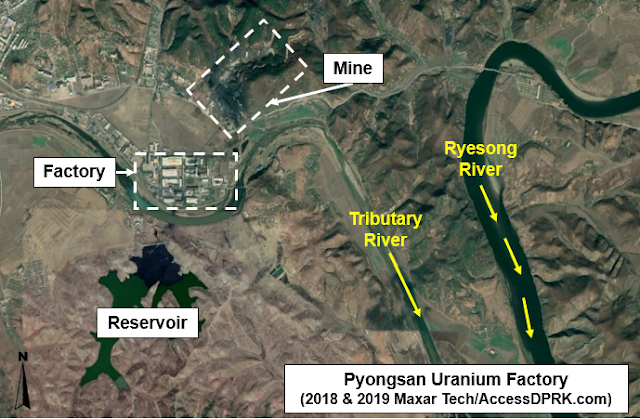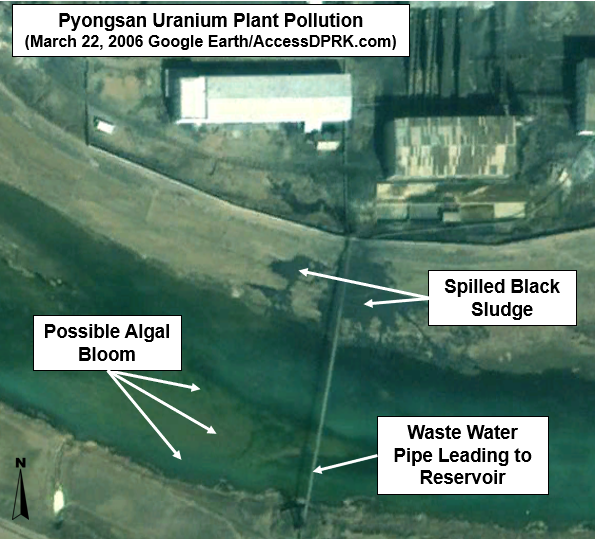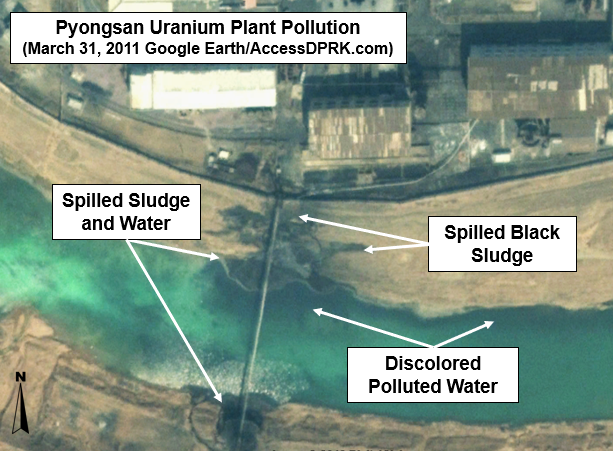(The second part of this article can be found here "A Pyongsan Addendum")
North Korea is a signatory to the Paris Accords, has made plans to reforest the country, and uses propaganda to show off how clean and beautiful the country is. While it is true that the North Korean countryside can be lovely and that there are densely forested mountains, North Korea is also an impoverished industrial country with a fascination with nuclear weapons. In such regimes, industrial and military progress always takes precedent over nature and the well-being of people. One such example of this is the Ryesong River, which is heavily polluted with waste material from the Pyongsan uranium mine and concentration plant.
One of North Korea's two known uranium processing plants, Pyongsan lies at the confluence of two rivers, the largest being Ryesong, which flows south for approx. 80 km, through the city of Kumchon and into the Han River estuary, which is shared by both Koreas, before emptying into the Yellow Sea.
The plant concentrates uranium from coal which is mined north of the plant. Uranium can be mined out of natural ores containing higher levels of the radioactive element or it can be found in lower quality coal - which North Korea has in abundance. Getting uranium from the coal involves a lot of steps and results in literally tons of toxic water and sludge being produced.
Normal international precautions for dealing with toxic materials include limiting the amount of polluted exhaust and aerosols, treating waste water, and storing waste materials in reservoirs that are lined with multiple layers of thick sheeting to prevent the contamination of ground water.
North Korea began constructing these uranium milling facilities in the 1980s. While there's only satellite evidence of leakage dating to 2003, it is highly likely that this has been ongoing for decades. The facility itself sits near the confluence of a smaller tributary river the larger Ryesong River, meaning that anything dumped into the tributary will quickly enter the Ryesong.
For additional detail about the plant itself, check out 38North's article.
Thanks to Google Earth, we can identify (unfortunately) that the pipe taking waste materials to the open reservoir has leaks and has been spilling toxic water into the Ryesong's tributary, which is then carried downriver until it finally empties into the Han River estuary and adds to the contamination of the Yellow Sea.
In this image from 2006, a clearly identifiable layer of black sludge has accumulated beneath the waste pipe as it leaves the factory. An apparent algal bloom is also visible. Small blooms naturally happen all over the world, but they can also be the result of certain kinds of pollution. The blooms release toxins of their own and can be very harmful to fish and people.
Fast forward to 2011 and you can see that the sludge has actually piled up on the riverbed, that it is coming from both ends of the pipe, and that the polluted water is flowing downstream as it hugs the north bank of the river heading to Ryesong.
In May 2017, a leak of an unidentified white-colored material can be spotted. Like the leak from 2011, this lighter material can clearly be seen being carried downstream.
The continual spilling of material can also be clearly seen during winter. The otherwise frozen tributary river is melted at each end of the pipe, where hot waste water is being dumped directly into the river.
The waste water reservoir occupies 338,000 square meters (33.7 hectares) and doesn't appear to be lined at all. This places any groundwater and wells at great risk as well as offers more opportunities for toxic materials to seep into the river.
Around 200,000 people live near the factory and downstream along the Ryesong River. Aside from the two main cities of Pyongsan and Kumchon, there are multiple small villages that line the riverbanks. The river is the only above-ground source of water for drinking, washing, and farming. Plants grown using polluted water often concentrate those pollutants and those are then passed on to the animals and people that eat them.
The various pollutants from the factory are then added to the other runoff received by the Yellow Sea, which is home to roughly 600 million people.
River pollution is a major problem in North Korea and even affects Pyongyang's main source of drinking water.
--Jacob Bogle, 8/3/2019
www.JacobBogle.com
Facebook.com/JacobBogle
Twitter.com/JacobBogle








Thank you Jacob Bogle for your work. I have been concerned about the nuclear contamination from the testing activities, but didn't think about the radioactive waste from the uranium plant. This is alarming, indeed.
ReplyDeletethank you for your writing from s'korea. i have not known about that
ReplyDeleteGreatly appreciated your detailed information. I haven't heard this revelation from major US news media, and it really appauled me. Since China and leftist current S.Korean government would not embarrass or directly raise the issue to N. Korea, how can we draw attention from other world leaders like president Trump.
ReplyDeleteKyong
I am surprised no South Korean press has picked up on this yet. I think the people of South Korea must be alerted because they are the ones who are directly impacted by the contamination. I have passed on the information to my friends in the press. We need to organize an outreach campaign, pronto.
ReplyDeleteHi Jacob, here's the Korean translation of your piece on uranium mine pollution. It has been posted on a South Korean internet news outfit Liberty Korea Post. I hope other Korean presses pick it up. In any case, we've started an awareness campaign on Twitter. http://www.lkp.news/news/article.html?no=6260
ReplyDelete